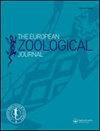栖息地和巢箱位置对红隼巢箱占用和繁殖成功的影响
IF 1.6
4区 生物学
Q2 ZOOLOGY
引用次数: 0
摘要
摘要巢箱经常用于许多鸟类,不仅是雀形目巢鸟,还有猛禽。增加巢穴的可用性,包括人工巢穴,是一种具有特定保护目标的栖息地增强策略。Kestrel Falco tinnuculus是一种愿意栖息在盒子里的物种。我们研究了箱附近的栖息地和巢箱位置对它们在中欧和波兰的职业和繁殖参数的影响。我们使用了17年来收集的400多个巢箱的数据。我们发现,红隼更喜欢挂在电线杆上和森林比例较低的地区的巢箱。繁殖成功率随草地比例的增加而降低,随单株数量的增加而增加。我们没有发现任何环境因素会影响红隼的生产力。我们的研究结果可能对未来的项目规划和保持人口稳定有用。我们建议将红隼的盒子放在耕地或草地上,远离大树,有马赛克般的栖息地。此外,我们建议将盒子挂在电线杆上,并避免将盒子挂到树上,尤其是森林附近。本文章由计算机程序翻译,如有差异,请以英文原文为准。
The influence of habitat and the location of nest-boxes on the occupation of boxes and breeding success of the Kestrel Falco tinnunculus
Abstract Nest-boxes are often used for many bird species, not only passerine hole-nesters but also birds of prey. Increasing the availability of nest-sites, including artificial ones, is one strategy of habitat enhancement with specific conservations goals. One of the species that willingly inhabits boxes is the Kestrel Falco tinnunculus. We studied the influence of habitat in the vicinity of boxes, and nest-box locations, on their occupation and the breeding parameters of Kestrels in Central Europe, in Poland. We used data collected over 17 years for more than 400 nest-boxes. We found that Kestrels prefer nest-boxes hung on power poles and in areas with a lower proportion of forests. Breeding success decreased with the increasing proportion of grasslands and increased with the increasing number of individual trees. We did not find any environmental components with an impact on productivity of Kestrels. Our findings could be useful in future program planning and maintaining stable populations. We recommend locating boxes for Kestrels in arable lands or grassy areas with a mosaic of habitats away from bigger trees. Furthermore, we recommend hanging boxes on power poles and also to avoid hanging boxes on trees, especially near forests.
求助全文
通过发布文献求助,成功后即可免费获取论文全文。
去求助
来源期刊

European Zoological Journal
Agricultural and Biological Sciences-Animal Science and Zoology
CiteScore
3.10
自引率
5.60%
发文量
80
审稿时长
30 weeks
期刊介绍:
The European Zoological Journal (previously Italian Journal of Zoology) is an open access journal devoted to the study of all aspects of basic, comparative and applied protozoan and animal biology at molecular, cellular, tissue, organ, organismal, population, and community-ecosystem level. Papers covering multiple levels of organization and integrative approaches to study animal form, function, development, ecology, evolution and systematics are welcome. First established in 1930 under the name of Il Bollettino di Zoologia, the journal now has an international focus, reflected through its global editorial board, and wide author and readership.
 求助内容:
求助内容: 应助结果提醒方式:
应助结果提醒方式:


